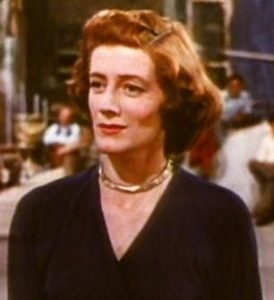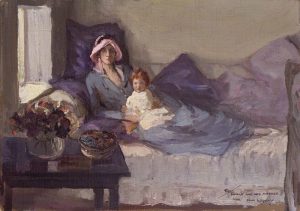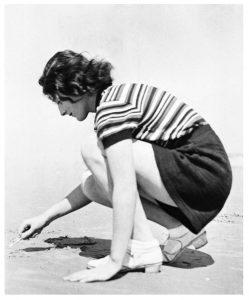Finest Hour 164
Mary Soames: Her Story

Winston Churchill, Parliament Square, London © Sue Lowry & Magellan PR
February 8, 2015
Finest Hour 164, Special Edition, September 2014
Page 07
By David Reynolds
Mary Soames was the last surviving child of Winston and Clementine Churchill, and the only one of their five children who really came to terms with bearing that distinguished family name. She enjoyed a fulfilled life as daughter, wife and mother before blossoming into an accomplished writer. She inherited her father’s energy and determination, while also displaying her mother’s charm and poise. But the empathy, ebullience and sense of fun were all her own.
Mary was born on 15 September 1922, the same month that her father bought Chartwell, his beloved country house on the edge of the Kentish Weald. She was by far the most junior of the surviving Churchill children (the infant Marigold having died in 1921)—eight years younger than Sarah, the next oldest. She was therefore brought up almost as an only child.
Her older siblings, Diana, Randolph and Sarah, had known a succession of homes, but Mary’s formative years were spent entirely at Chartwell. There she revelled in country life, particularly horses, and developed a lifelong love of gardening. And, whereas her brother and sisters had suffered a series of governesses, she was raised largely by Clementine’s young cousin, Maryott Whyte, who joined the Churchill household as a nanny at Mary’s birth and stayed for over twenty years. “Nana” became the centre of Mary’s youth and the nurturer of her lifelong Christian faith.
Relations with her parents were at this stage admiring rather than intimate. If Clementine made a suggestion, Mary’s instinctive reaction was: “I must ask Nana.” But in the winter of 1935-36, conscious of the distance between them, her mother took Mary skiing in Austria, and this became an annual fixture on the family calendar. “It was chiefly during these lovely skiing holidays,” Mary later wrote, “that I started to know my mother more as a person than a deity.”
With the outbreak of war in September 1939, Mary followed her parents to London. Then, during the Blitz, she was packed off to Chequers, the prime minister’s country retreat in Buckinghamshire. Keen for more of the action, she joined the Auxiliary Territorial Service in September 1941 and served in one of the new “mixed” anti-aircraft batteries. Life in tents and draughty barracks was a marked change from her privileged life to date. At one army dance, she teased an American soldier about his big feet, whereupon he put her over his knee and gave her “about thirty good-natured whacks.” His buddy told Time magazine: “She’s a regular guy and, like her old man, can take it.”
Mary’s battery served in London and on the coast during the V-bomb raids of 1944, before moving on to Belgium and Germany. Excitement of a different sort came from travelling abroad as her father’s aide-de-camp. In the summer of 1943 she went to Quebec and Washington; returning from Quebec on HMS Renown, she was almost washed overboard in a heavy sea. In July 1945 she accompanied Winston Churchill to Potsdam for the final summit of World War II with President Truman and Marshal Stalin.
On 25 July, during a break in the conference, father and daughter flew back to London for the results of the general election. The Conservative Central Office remained confident of victory; Mary even left half her luggage behind at Potsdam. But the election proved a Labour landslide and for a while, Winston and Clementine were close to a nervous collapse as they struggled to construct a new life in the vacuum following the fall from power—the sudden absence of red boxes, of the sense of urgency and purpose. Mary, demobbed in April 1946, was particularly helpful to her mother as they reopened Chartwell and set up a new home in London.
Her personal life blossomed. After a whirlwind romance, she and Christopher Soames (later Baron Soames), a Coldstream Guards officer, were married in February 1947 in St. Margaret’s, Westminster, the same church as her parents thirty-nine years before. Clementine took some persuading—she had talked Mary out of a rash engagement in 1941. But on their honeymoon Christopher was taken ill with a duodenal ulcer, whereupon Clementine proposed that he retire from the Army, live in the farmhouse down the hill from Chartwell, and take over running the estate. So Mary returned to her Kentish roots, this time with a home and family of her own.
Between 1948 and 1959 Mary gave birth to three sons and two daughters. She also supported her husband’s political career as a Conservative MP for Bedford (1950-66), campaigning vigorously on his behalf. After he lost his seat, she accompanied him on a series of foreign appointments, particularly relishing her time as hostess in the splendid Paris Embassy (1968-72). The couple were in Brussels from 1973 to 1976, when Christopher was the first British vice-president of the European Commission.
Between December 1979 and April 1980, when Christopher was the last Governor of Southern Rhodesia, the close personal bond forged by the Soameses with Robert Mugabe and his wife was essential for the reasonably smooth transfer of power. Mary felt the subsequent fate of Zimbabwe almost as a personal betrayal.
But another Mary was about to bloom. Sir Winston, who died in 1965, was the subject of a multi-volume biography, started by his son Randolph and being completed by the historian Martin Gilbert. Christopher suggested that Mary should write a life of her mother Clementine, and Mary took up the idea with enthusiasm. Before her death in 1977, Clementine herself had read all the draft chapters up to the Great War.
Mary was touched and delighted with the commission, but also a little daunted, having “never before written so much as a pamphlet,” as she admitted in the preface. Yet Clementine Churchill was published in 1979 to enormous acclaim, winning the Wolfson Prize and plaudits from reviewers. A.J.P. Taylor called it “a delightful book…affectionate and also frank.” It was indeed this remarkable mixture of feeling and detachment that made the book so appealing. Mary showed how much her mother had done to sustain Winston’s career—“my life’s work,” as she had put it. But the book also revealed the intense strains this imposed on Clementine’s highly strung nature.
Suddenly Mary was recognised as her father’s as well as her mother’s daughter, with a good deal of Sir Winston’s literary talent. Other books followed, including a notable work on her father’s paintings, a widely read collection of her parents’ letters, and an autobiography up to 1945, drawing on her extensive diaries. (See book reviews, pages 20-25.)
In 1989 Mary was appointed chairman of the Board of Trustees of the National Theatre, a political appointment, greeted without enthusiasm in thespian circles. The Soameses had not been theatre-goers and, during an early meeting Mary pushed a note to the NT’s director, Richard Eyre: “Who is Ian McKellen?” But she threw herself into the new task in a typical hands-on way, developing a keen interest in the theatre, and Eyre found her an invaluable supporter. At her farewell party in 1995, he said how much he would miss her “gossip, guidance, champagne, 7:45 am phone calls, enthusiasm, wisdom and friendship.” She replied: “You go too far, but then you often do, dear Richard.”
Behind the scenes, she quietly maintained a concern for former members of the family’s staff and championed many public Churchill causes, not least the Archives Centre at Churchill College, Cambridge, where she was elected an Honorary Fellow. She was also the assiduous Patron of The Churchill Centre, attending its gatherings and talking freely and informally with all who attended. On one occasion, asked to present a VIP with a picture of Chartwell that had unfortunately failed to arrive, she carried off the potential embarrassment with great aplomb, imaginatively recreating the beauties of the picture with a verve and humour that delighted the whole audience.
Mary described herself as a “child of consolation,” product of Winston and Clementine’s grief at their daughter Marigold’s premature death in 1921. In due time, she consoled her parents, supported her husband and nurtured her children. But she also developed a distinctive voice of her own as a woman and an author.
Dr. Reynolds is the author of the seminal work, In Command of History: Churchill Fighting and Writing the Second World War (2007) and is Professor of International History and a Fellow of Christ’s College, Cambridge. This text is slightly amended from an obituary first published in The Guardian on 2 June 2014.
Subscribe
WANT MORE?
Get the Churchill Bulletin delivered to your inbox once a month.






